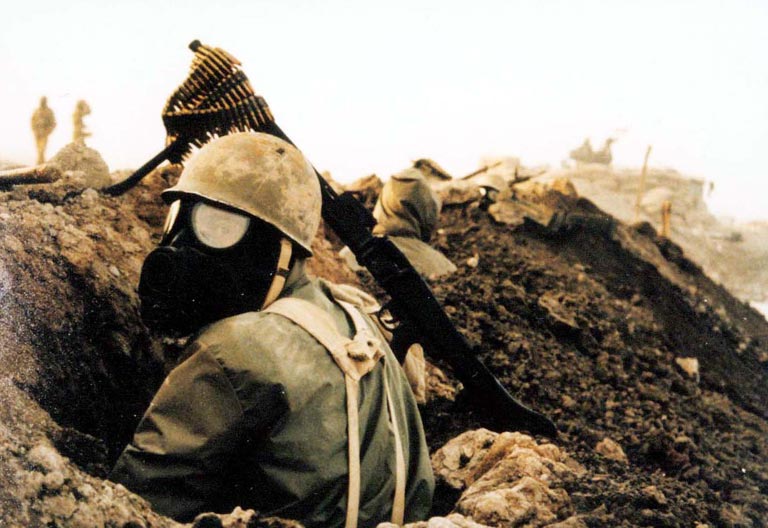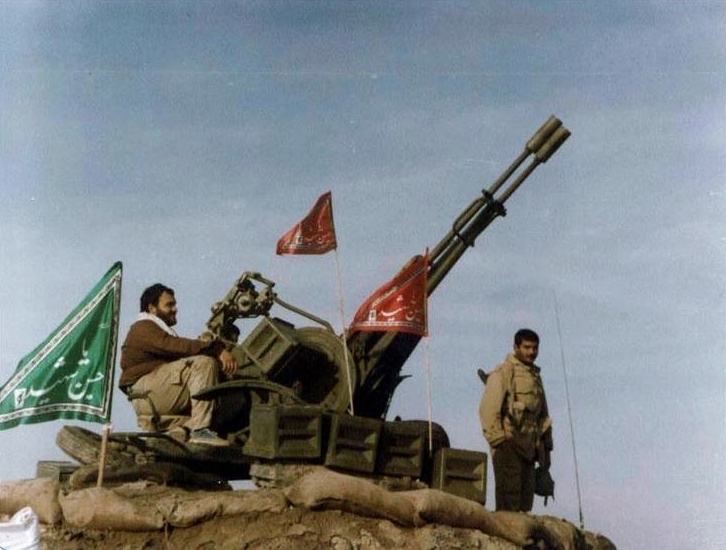(Note: History in Focus is a new post style where I discuss a topic simply by posting photos [and if applicable, videos] of the event in question. I often found that this helps the reader to understand a topic much more thoroughly).
The Iran-Iraq war was a devastating eight-year war fought between the two countries between September 1980 and August 1988. The war started with a simultaneous air and land Iraqi offensive onto Iran which caught the Iranians off guard (with Iran still reeling from the chaos caused via their revolution).
 |
| Iraqi gains (between 1980-82) and Iranian gains (1982-88) |
The Iraqis made early gains, capturing the strategic border city of Khorramshar after a lengthy and bloody siege (The city was nicknamed "Khunistan" [City of Blood] by both sides during the conflict) and initiated the siege of Abadan. Much of the city of Abadan, including the oil refinery which was one of the world's largest refinery with capacity of 680,000 barrels per day, was badly damaged and almost destroyed by the siege.
 |
| Armed Iranian woman in Khorramshar during the siege |
 |
| Oil wells on fire, outside Abadan, Iran. |
 |
| Iraqi artillery battalion. |
 |
| Iraqi soldiers posing after a victory |
 |
| Trench warfare was common, as in WWI. |
For much of 1981 and 1982, the Iraqi offensive halted in a stalemate. In 1982, Iraqi soldiers were repelled from Iranian territory and it seemed that the conflict would end with Iraq suing for peace. It did not, Iran was later on the offensive, dragging the war on for another six years.
 |
| Iraqi army and militia positions in the war (from HealingIraq.blogspot.com) |
 |
| The war saw the mass recruitment of child soldiers |
 |
| Child soldiers on the Iranian frontier |
 |
| Sudanese volunteers marching. They joined the Iraqi Army in 1983. |
 |
| Iraqi tank and soldiers cross beyond the Karun river |
 |
| Iraqi soldiers in combat. |
The Iranian offensive was slowed down and eventually halted by the deployment of chemical weapons, mainly mustard gas, by the Iraqi army. Iraq would later use these weapons for the remainder of the war, most notably in the gassing of the Kurdish village of Halabja.
 |
| Iranian soldier wears a gas mask and takes cover in a trench |
 |
| Locations of the use of chemical weapons |
 |
| Iranian soldiers equipped with gas masks. It helped them survive. |
 |
| Victims of the gas attack at the Kurdish village of Halabja, Iraq. 5,000 died at least. |
The war saw the constant bombardment, by both sides, of the other's cities and towns. Missiles and air raids were launched to bomb each other into submission. This was later dubbed as the "War of the Cities".
 |
| Kuwait was attacked by Iran in an airstrike over their support for Iraq |
|
 |
| Iranian Revolutionary Guard mounting an Anti-Air gun in Iran |
 |
| Iranian children lie dead after a school was bombed in 1987 |
Tanker Wars:The conflict spilled into the Persian Gulf; both countries produced large amounts of oil and it was viewed that attacking and disabling oil installations in the combatant's country would damage their economy and eventually bankrupt them. However, this mini-war caused the US navy (a navy stronger than both Iran's and Iraq's combined) to escort Gulf oil tankers; there were still incidents. Iraq 'accidentally' bombed a US warship and Iran's practice of laying mines in the sea (which had damaged a US frigate) caused an American strike on the Iranian navy, taking out five Iranian naval vessels.
 |
| Oil tanker scuttled in the Shatt al Arab waterway on Saddam's orders to prevent sea access to southern Iraq |
 |
| The USS Stark after being hit by an Iraqi fighter plane |
 |
| Iranian boats like these littered the Gulf. |
 |
| Oil tanker in flames after being hit by an Iranian missile. |
After the USS Stark incident, American naval vessels were on high alert. In July 1988, the cruiser USS Vincennes shot down Iran Air Flight 655, killing all 290 passengers and crew on board. The American government claimed that the airliner had been mistaken for an Iranian F-14 Tomcat, and that the Vincennes was operating in international waters at the time and feared that it was under attack, which later appeared to be untrue.The Iranians, however, maintain that the Vincennes was in fact in Iranian territorial waters, and that the Iranian passenger jet was turning away and increasing altitude after take-off. U.S. Admiral William J. Crowe also admitted on Nightline that the Vincennes was inside Iranian territorial waters when it launched the missiles. The issue remains a controversial point in Iranian-American relations to this day.
Home Front:As in WWI and WWII, the war brought in the massive pouring of military volunteers and aid to each country's armed forces.
 |
| Iranian children offer their spare savings to the war-front. |
 |
| Military volunteers en route to the front-lines. |
 |
| Most were never seen of again. |
 |
| Iranian volunteers took up arms by the busloads (literally) |
 |
| Iranian volunteers marching to the front-line. |
 |
| Iranians from across the country joined the army |
 |
| Civilians stock up supplies in a mosque along the frontline in Iran |
 |
| Iran's first president, Banisadr, visiting an injured soldier. |
 |
| Azadi sports stadium in Tehran was a focal recruitment area |
International Reactions:The UN deployed several observers to Iran to assess if chemical weapons were used and to report on how much were used.
 |
| UN weapons inspectors at work. |
 |
| Taking photos of artillery shells |
 |
| And of children... (???) |
 |
| UN observers assess the level of chemicals used. |
Casualties (graphic):The war left a million dead, and hundreds of thousands injured.
Peace:Peace was achieved in 1988. 100,000+ civilians killed on both sides, 320,000–720,000 Iraqi soldiers and militia killed and 150,000–375,000 Iranian soldiers and militia killed. Over a trillion dollars in damages occurred. This was the longest conventional war of the 20th century and one of the most brutal.
Iraq erected 101 statues with pointing fingers towards Iran, six miles away from the border, in memory of Iraqis killed during the Iran-Iraq War. The statues were destroyed by the British on March 31, 2003.




























